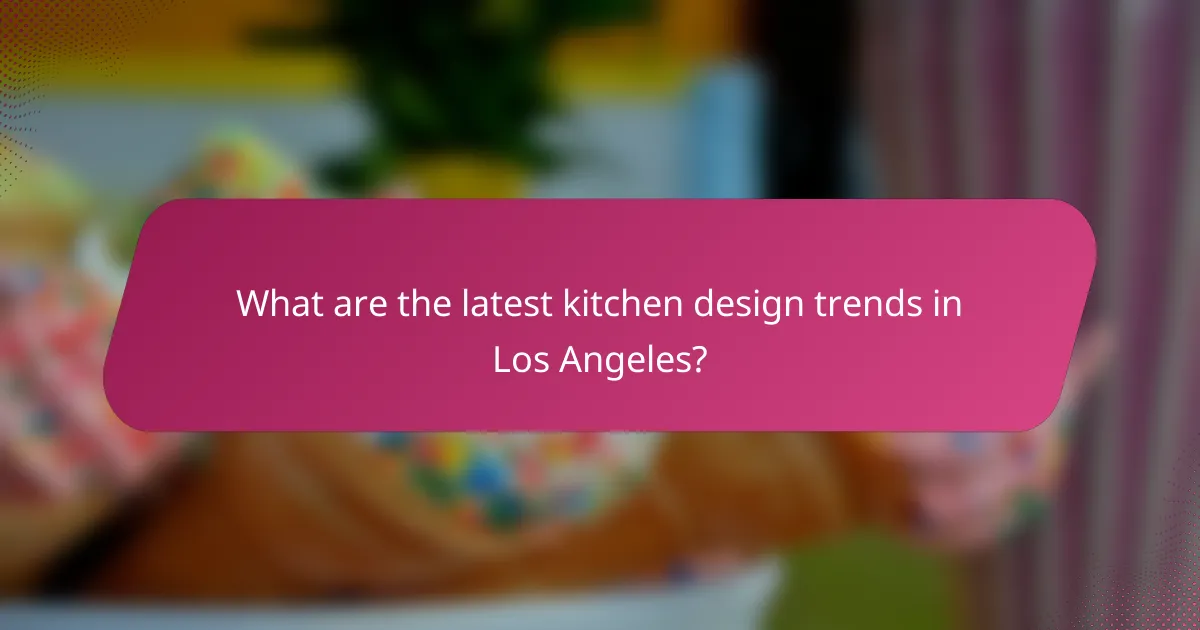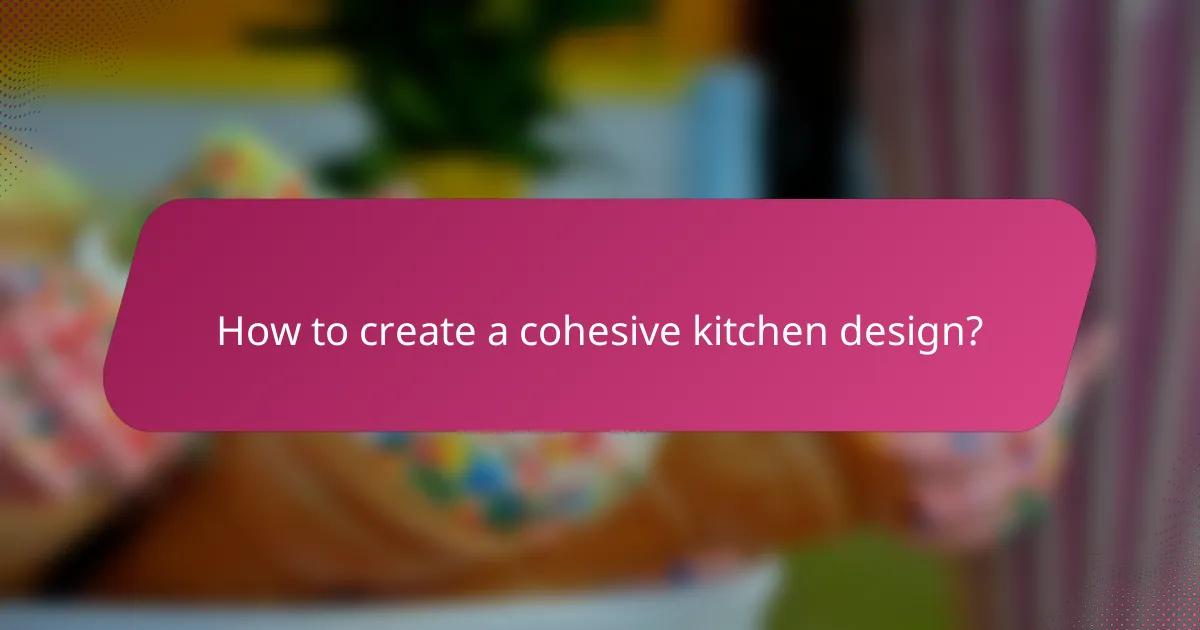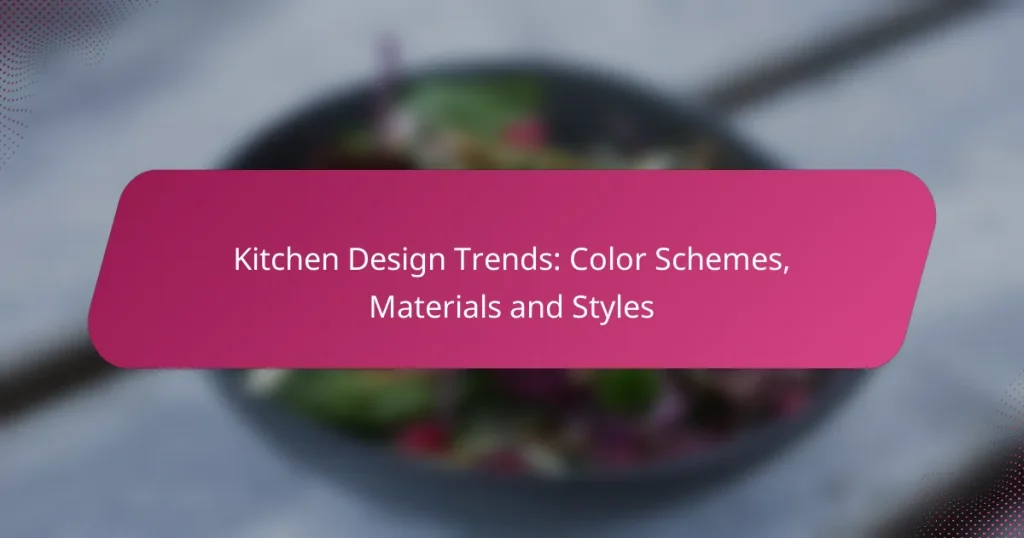In today’s kitchen design landscape, vibrant aesthetics and sustainable materials are at the forefront, with homeowners aiming to create functional yet stylish spaces. Selecting the right color scheme is crucial, as it can significantly impact the kitchen’s atmosphere and functionality. Additionally, trending materials like quartz and recycled options provide both durability and aesthetic appeal, making them popular choices for modern kitchens.

What are the latest kitchen design trends in Los Angeles?
The latest kitchen design trends in Los Angeles emphasize vibrant aesthetics, sustainable materials, and innovative technology. Homeowners are increasingly seeking to create functional spaces that reflect their personal style while incorporating modern conveniences.
Bold color schemes
Bold color schemes are gaining popularity in Los Angeles kitchens, moving away from traditional whites and neutrals. Rich hues like deep blues, emerald greens, and vibrant reds can create a striking focal point and add personality to the space.
When choosing a bold color, consider how it complements existing elements like cabinetry and countertops. Accent walls or colorful backsplashes can be effective ways to introduce these shades without overwhelming the entire kitchen.
Natural materials
Natural materials are a key trend, with a focus on sustainability and organic aesthetics. Wood, stone, and bamboo are frequently used for countertops, cabinetry, and flooring, providing warmth and texture to the kitchen environment.
Incorporating reclaimed wood or sustainably sourced stone can enhance the eco-friendliness of your kitchen. Look for finishes that highlight the natural grain and imperfections of these materials to create a unique and inviting space.
Minimalist styles
Minimalist styles continue to dominate kitchen design, emphasizing clean lines and uncluttered spaces. This approach often features flat-panel cabinetry, integrated appliances, and a limited color palette to create a serene atmosphere.
To achieve a minimalist look, focus on functionality and organization. Utilize hidden storage solutions and choose appliances that blend seamlessly into the cabinetry to maintain a sleek appearance.
Smart technology integration
Smart technology integration is transforming kitchens in Los Angeles, making them more efficient and user-friendly. Features like smart refrigerators, touchless faucets, and automated lighting systems are becoming standard in modern designs.
When incorporating smart technology, consider how it enhances your cooking and entertaining experience. Look for devices that offer convenience, such as programmable ovens or voice-activated assistants, to streamline your kitchen tasks.

How to choose the right color scheme for your kitchen?
Choosing the right color scheme for your kitchen involves considering factors like natural light, adjacent rooms, and the psychological effects of colors. A well-selected palette can enhance the space’s functionality and aesthetic appeal, making it both inviting and practical.
Consider natural light
Natural light significantly impacts how colors appear in your kitchen. Rooms with ample sunlight can handle bolder colors, while darker spaces may benefit from lighter shades to create an illusion of brightness. Aim for a balance that complements the light available throughout the day.
For instance, if your kitchen receives morning light, soft yellows or warm whites can enhance the warmth. In contrast, kitchens with less natural light might look better with cooler tones like soft blues or greens to keep the atmosphere fresh.
Match with adjacent rooms
When selecting a color scheme, ensure it harmonizes with the colors of adjacent rooms. This creates a cohesive flow throughout your home, making spaces feel interconnected. Consider the style and color palette of nearby areas, such as the dining room or living room.
A common approach is to use a dominant color in the kitchen that reflects or complements the hues in adjacent spaces. For example, if your living room features earthy tones, incorporating similar shades in your kitchen can enhance continuity.
Use color psychology
Color psychology plays a crucial role in setting the mood of your kitchen. Different colors evoke various emotions and can influence how you feel while cooking or entertaining. For example, warm colors like red and orange can stimulate appetite and energy, while blues and greens promote calmness and relaxation.
When choosing colors, think about the atmosphere you want to create. If you often host gatherings, vibrant colors may encourage social interaction. Conversely, if you prefer a tranquil cooking environment, opt for softer, cooler tones that foster a sense of peace.

What materials are trending for kitchen countertops?
Trending materials for kitchen countertops include quartz, recycled materials, and butcher block. These options offer a blend of durability, aesthetic appeal, and sustainability, catering to diverse design preferences and practical needs.
Quartz surfaces
Quartz surfaces are a popular choice due to their durability and low maintenance requirements. Made from engineered stone, they combine natural quartz crystals with resins, resulting in a non-porous surface that resists stains and scratches.
When selecting quartz, consider the color and pattern options available, as they can mimic natural stones like marble or granite. Prices typically range from moderate to high, depending on the brand and design complexity.
Recycled materials
Recycled materials, such as glass, paper, and concrete, are gaining traction for eco-conscious homeowners. These countertops are made from repurposed materials, reducing waste and environmental impact while offering unique aesthetics.
When choosing recycled materials, look for certifications that ensure sustainability and quality. Prices can vary widely, often starting at a moderate range, but can increase based on the material’s composition and design intricacies.
Butcher block
Butcher block countertops are favored for their warm, natural look and versatility. Typically made from hardwoods like maple or walnut, they provide a sturdy surface ideal for food preparation.
To maintain butcher block surfaces, regular oiling is necessary to prevent drying and cracking. Prices are generally moderate, but the cost can vary based on the wood type and thickness. Consider sealing options to enhance durability and resistance to moisture.

What kitchen styles are popular in urban areas?
Urban areas often favor modern and functional kitchen styles that maximize space and efficiency. Popular styles include contemporary design, industrial aesthetics, and farmhouse chic, each offering unique characteristics suited to city living.
Contemporary design
Contemporary kitchen design emphasizes clean lines, minimalism, and a blend of materials. This style often incorporates sleek cabinetry, open shelving, and neutral color palettes, making it ideal for smaller urban spaces.
To achieve a contemporary look, focus on high-quality materials such as quartz countertops and stainless steel appliances. Consider integrating smart home technology for added convenience and efficiency.
Industrial aesthetics
Industrial aesthetics draw inspiration from warehouses and factories, featuring raw materials like exposed brick, metal fixtures, and reclaimed wood. This style is perfect for urban lofts and spaces with high ceilings.
When designing an industrial kitchen, aim for a mix of textures and finishes. Use pendant lighting with an unfinished look and open shelving to showcase functional items. Keep the color scheme muted, with grays, blacks, and browns predominating.
Farmhouse chic
Farmhouse chic blends rustic charm with modern functionality, making it a popular choice in urban settings. This style often includes elements like shiplap walls, vintage-inspired fixtures, and a warm color palette.
To create a farmhouse chic kitchen, incorporate a large farmhouse sink, wooden accents, and open shelving for a cozy feel. Mixing new appliances with vintage decor can enhance the overall aesthetic while maintaining practicality.

What are the key factors in selecting kitchen appliances?
When selecting kitchen appliances, key factors include energy efficiency, smart features, and brand reliability. These elements not only influence the functionality of your kitchen but also impact long-term costs and user experience.
Energy efficiency
Energy efficiency is crucial when choosing kitchen appliances, as it affects both your utility bills and environmental impact. Look for appliances with high energy ratings, such as those certified by ENERGY STAR, which can save you a significant amount on energy costs over time.
Consider the energy consumption of each appliance. For instance, modern refrigerators typically use about 30% less energy than older models. Investing in energy-efficient appliances can lead to savings of hundreds of dollars annually.
Smart features
Smart features in kitchen appliances enhance convenience and control. Appliances with Wi-Fi connectivity allow you to monitor and manage them remotely, providing flexibility in your cooking and energy management.
Examples include ovens that can be preheated from your smartphone or refrigerators that track food inventory. These features not only simplify meal preparation but can also help reduce food waste by reminding you of expiration dates.
Brand reliability
Brand reliability is essential for ensuring your kitchen appliances perform well over time. Researching customer reviews and ratings can provide insight into the durability and service quality of different brands.
Reputable brands often offer warranties that cover repairs or replacements, which can save you money in the long run. It’s advisable to choose brands known for their customer service and product longevity to avoid frequent replacements or repairs.

How to create a cohesive kitchen design?
To create a cohesive kitchen design, focus on harmonizing colors, materials, and styles throughout the space. This involves selecting a unified color palette, complementary materials, and consistent design elements that work together to form a seamless look.
Color Schemes
Choosing the right color scheme is essential for a cohesive kitchen design. Popular palettes include neutral tones with bold accents, or monochromatic schemes that use varying shades of a single color. Aim for a balance between light and dark hues to create depth and interest.
Consider the psychological effects of colors; for example, blues and greens can evoke calmness, while yellows and reds may stimulate appetite. When selecting colors, think about how they will interact with natural light and existing furnishings.
Materials
Materials play a crucial role in achieving a cohesive kitchen design. Common choices include wood, stone, and metal, each offering unique textures and finishes. Ensure that the materials you select complement each other and align with your overall design theme.
For instance, pairing a sleek quartz countertop with rustic wooden cabinets can create an appealing contrast. Be mindful of durability and maintenance; materials like stainless steel are practical for high-traffic areas, while softer finishes may require more care.
Styles
Incorporating a consistent style is vital for a cohesive kitchen. Popular styles include modern, traditional, farmhouse, and industrial. Choose a style that reflects your personality and fits well with the rest of your home.
When selecting fixtures and appliances, ensure they align with your chosen style. For example, vintage-style faucets work well in a farmhouse kitchen, while minimalist designs suit modern aesthetics. Avoid mixing too many styles to maintain a unified look.


